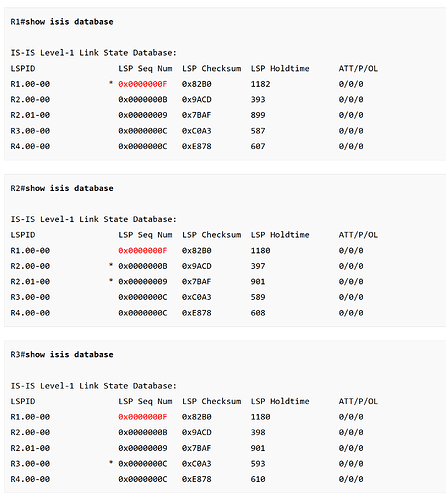This topic is to discuss the following lesson:
Hi Rene,
Is there any way to make it P2P like OSPF ? Thanks
br//zaman
Hello Zaman,
There is yes, you can use this command:
R1(config-if)#isis network ?
point-to-point Specify ISIS point-to-point networkYou can use this on broadcast networks (like Ethernet) when you only have two routers. This disables the creation/election of a DIS so it’s more efficient.
Rene
Hello Rene
i have Problem with understanding that DIS / PSN
please explain it to me more simple
Which is far less than the six neighbor adjacencies we would have without the pseudonode where each router would report three neighbor adjacencies.
As per this sentence there are only 3 neighbor adjacencies. But when we configured ISIS each routers have full mesh Neighbourship with each other .I am still confuse how does DIS help to reduce the neighbor adjacencies ?
Thanks in advance
Hello BGP
With the pseudonode, there are a total of four adjacencies in the whole topology. If there were no pseudonode, each router would have to create an adjacency with every other router. That means:
- R1 - R2
- R1 - R3
- R1 - R4
- R2 - R3
- R2 - R4
- R3 - R4
So by using the pseudonode you reduce the number of adjacencies, you reduce the complexity of the topology, and you reduce the number of updates that have to be exchanged between particular routers.
Actually, as per the sentence, each router reports three adjacencies. The total number of adjacencies or unique pairs of routers in the list above is six.
The idea is similar to the use of the DR and BDR in OSPF. In order to appreciate this even more, let’s take an example of 10 routers. WIth 10 routers using a pseduonode, you have 10 adjacencies. Without a pseudonode, if you do the calculations you’ll find you will have 45 adjacencies!
I hope this has been helpful!
Laz
Another issue is that the link-state database can grow exponentially. Can you explain a bit more about it? How LSD may grow without Pseudonode. As Each router will send the LSP and others are going except it. Eventually, all routers receive the LSP from each router in LAN. In that case how come link-state database got reduced with pseudonode
I don’t quite understand.
In OSPF will not create adjacencies between BDR. Thus, it can reduce the number of neighbors.
But in ISIS, it still creates adjacencies for each one, what is the point?
Hello Kevin
When implementing OSPF, if there are many routers connected to the same broadcast domain, a DR and BDR election takes place. All routers in the broadcast domain create two neighbor adjacences: One to the DR and one to the BDR. There is also an adjacency between the DR and BDR.
When implementing IS-IS, there is a similar mechanism. The Designated IS (DIS) is elected and it creates a virtual router called a pseudonode. This pseudonode plays the corresponding role of the DR in OSPF. However, in this case, each router will create a single neighbor adjacency with this virtual device. Even the physical DIS creates an adjacency (internally) to the pseudonode.
So each IS-IS router doesn’t create an adjacency with every other router in the broadcast domain, but only a single adjacency to the pseudonode. Does that make sense?
I hope this has been helpful!
Laz
Thank you in advance. I’m still a little confused
You said
“So each IS-IS router doesn’t create an adjacency with every other router in the broadcast domain, but only a single adjacency to the pseudonode”
But I saw each router create an adjacency with every other route in this picture
How does this make sense?
Hello Kevin
Ah yes, that’s a great observation! Let me clarify. The purpose of the DIS and pseudonode is to reduce the number of adjacencies in the flooding of LSDB updates, not the actual discovery of neighbors or forming of relationships.
The output of the show isis database does indeed show a full mesh of adjacencies, but these adjacencies weren’t discovered using individual exchanges of updates between those neighbors. They were established with the exchange of updates between each individual IS-IS router and the pseudonode alone. This reduces the number of exchanged packets.
So even though routers discover each other, full adjacencies (for the purpose of database synchronization) on broadcast networks are only formed with the pseudonode (DIS). This is where the efficiency comes in – rather than each router having a full adjacency with every other router, they all just have one with the pseudonode. This minimizes the LSDB update flooding.
Unlike OSPF, IS-IS makes the distinction between:
- adjacencies for the purpose of database synchronization
- and IS-IS neighbor adjacencies
I hope this has been helpful!
Laz
